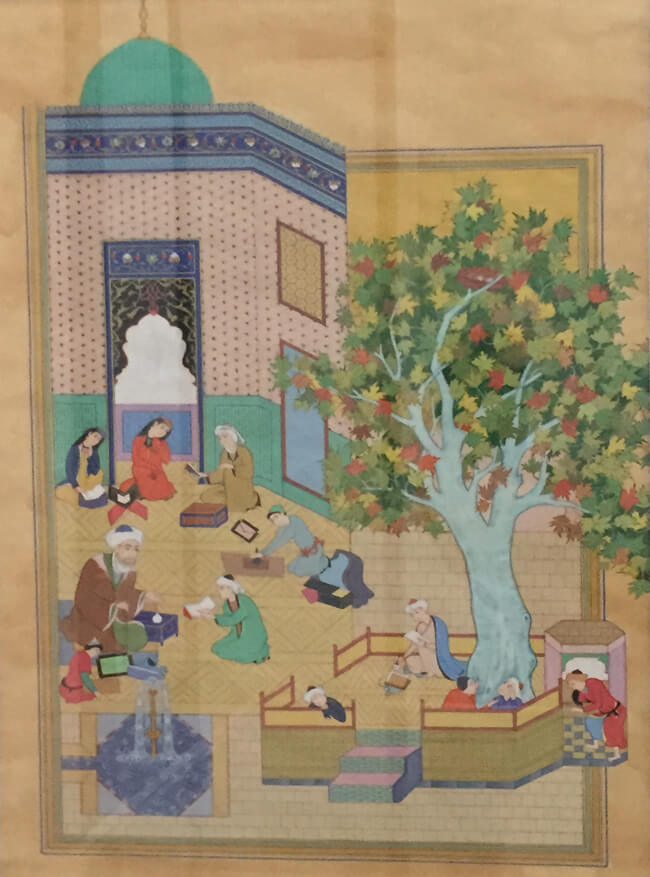-

 Know, the true nature of your Beloved.
Know, the true nature of your Beloved.
In His loving eyes, your every thought,
Word and movement is always –
Always Beautiful.
~ Hafiz
The Golden Chain

Shaykh Khas Muhammad ash-Shirwani
Shaykh Khas Muhammad ash-Shirwani (may God sanctify his innermost being) is the thirty third Shaykh in the Naqshbandi Golden Chain.
He was born in Kulal, in 1786 AD, in a district of Shirwan, which is located in present-day Azerbaijan, between the western shores of the Caspian Sea and the Kura River.
He was tall, with a fair complexion, having dark coloured eyes and a black beard.
He received his first teachings in Sufism from his family. He followed and taught the Shafi School of Divine Law, having memorized Imam Shafi’s ‘Mother of All Books’ (Kitab ul-Umm). He was known for his eloquence of speech, clarity of thinking, legal rulings and spiritual knowledge. By the age of twenty, he was able to give judicial decisions.
In ‘Muslim Resistance to the Tsar, Shamil and the Conquest of Chechnia and Daghestan’, Gammer says, “The seed sown by Shaykh Ismail found fertile ground in Daghestan, where it was transferred by another of his disciples, al-Shaykh Khas Muhammad ash-Shirwani. He ordained al-Shaykh Muhammad al-Yaraghi who, in turn, ordained Jamal al-Din al-Ghazi-Ghumuqi.”
Benningsen and Wimbush in their book on Sufism and the Soviet Union state, “The Naqshbandi Order was to play a very important role in Caucasian history. Iron discipline, total dedication to its ideals and the strict hierarchy on which it was based, explain the epic resistance of the Caucasian mountaineers to Russian conquest – a resistance that lasted from 1824 to 1855 – in which not only all the leaders of the movement but also the local authorities and the majority of the fighters were Naqshbandis. It can be said that the nearly fifty year long Caucasian wars made an important contribution to the material and moral ruin of the Tsarist empire and hastened the downfall of the Russian monarchy.
The brotherhood achieved another deep and long-lasting result . . . it transformed the half-pagan mountaineers into strict orthodox Muslims and introduced Islam into the animist areas of upper Chechnia and among the Circassian tribes of the western Caucasus . . .
The subsequent massive migration of the Caucasian Muslims to Turkey did not destroy the Naqshbandiyya in Daghestan and Chechnia; its roots had spread too wide and deep.”
Shaykh Ahmad al-Kawkasi described the following miracle, “One time I was travelling from the city, across the forest, to another city. On my way, snow was falling heavily and a great wind was blowing. The snowfall cleared and in its stead rain poured down, making the roads like rivers. I had no choice but to pass through that forest. I entered it as night was approaching, and got lost in the middle. The skies were pouring rain, night was over-taking me, the flood was increasing and I did not know where to go. I came to a river running through the forest, that was like the ocean, full of waves. The bridge over it was wrecked but I had to cross. The river was raging, rising higher and higher, until it reached up the legs of my horse, to my legs. I feared both the horse and I would drown. I raised my hands and asked my Lord, ‘O, God, help me in this difficulty.’ I immediately heard a voice behind me saying, ‘O Ahmad, why are you calling me and bringing me from my house?’ I looked and saw Shaykh Khas Muhammad behind me but he was huge. He said, ‘Hold my hand and cross the river with me.’ I felt fear. He said, ‘When you are with us, you must not feel fear.’ Then we crossed the river to the other side. He said, ‘Now you are safe’ and he disappeared. When I reached my destination and went to the mosque, I saw him sitting there, and so I asked him, ‘How did you come?’ He replied, ‘O Ahmad, for us there are no boundaries – we can be anywhere and everywhere, at any time.”
Shaykh Khas Muhammad died in 1844 AD, while returning from the Hajj pilgrimage to Mecca. He was buried in Damascus, in the Mount Qasioun area. He passed the authority of the Order to his successor, Shaykh Muhammad Effendi al-Yaraghi, according to the directions of their Shaykh, Shaykh Ismail ash-Shirwani.
May God be well pleased with him.
Source:- ‘The Naqshbandi Way – History and Guidebook of the Saints of the Golden Chain’ by Mawlana Shaykh Hisham.
